solid state lighting
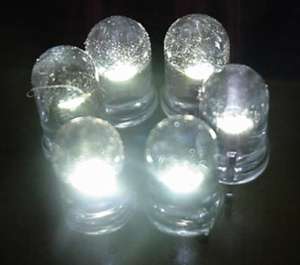
White LED lighting.
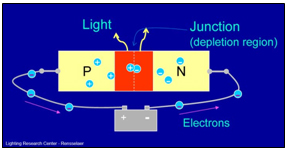
How an LED works.
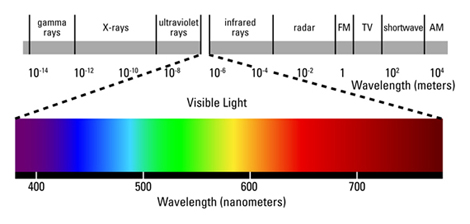
Electromagnetic spectrum with visible region expanded.
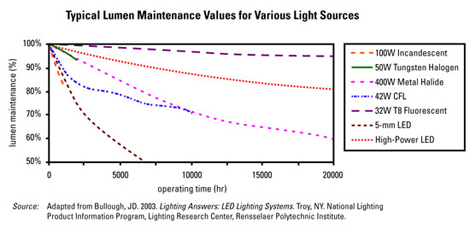
Lumen maintenance values.
Solid state lighting (SSL) represents the next frontier of lighting technology. It utilizes light-emitting diodes (LEDs) or organic light-emitting diodes (OLEDs).
Light-emitting diodes (LEDs)
LEDs have been around since the 1960s, but they are just now reaching the levels of luminous output and power that open the door to more applications. For example, today's commercially available LEDs offer energy efficiency, maintenance savings, impact resistance, durability, and other benefits for traffic signals, exit signs, and other specialty applications. White LEDs are approaching performance levels that make them attractive for use in automobiles, aircraft, and elevators. For most general illumination applications, however, current LEDs cannot yet compete with traditional sources in performance or cost.
Organic light-emitting diodes (OLEDs)
OLEDs are based on organic (carbon-based) materials. In contrast to LEDs, which are small point sources, OLEDs are made in sheets which provide a diffuse area light source. OLED technology is developing rapidly and is increasingly used in display applications such as cell phones and PDA screens. However, OLEDs are still some years away from becoming a practical general illumination source. Additional advancements are needed in light output, color, efficiency, cost, and lifetime.
How LEDs work
LEDs differ from traditional light sources in the way they produce light. In an incandescent lamp, a tungsten filament is heated by electric current until it glows or emits light. In a fluorescent lamp, an electric arc excites mercury atoms, which emit ultraviolet (UV) radiation. After striking the phosphor coating on the inside of glass tubes, the UV radiation is converted and emitted as visible light.
An LED, in contrast, is a semiconductor diode. It consists of a chip of semiconducting material treated to create a structure called a p-n (positive-negative) junction. When connected to a power source, current flows from the p-side or anode to the n-side, or cathode, but not in the reverse direction. Charge-carriers (electrons and electron holes) flow into the junction from electrodes. When an electron meets a hole, it falls into a lower energy level, and releases energy in the form of a photon (light).
The specific wavelength or color emitted by the LED depends on the materials used to make the diode. Red LEDs are based on aluminum gallium arsenide (AlGaAs). Blue LEDs are made from indium gallium nitride (InGaN) and green from aluminum gallium phosphide (AlGaP). "White" light is created by combining the light from red, green, and blue (RGB) LEDs or by coating a blue LED with yellow phosphor.
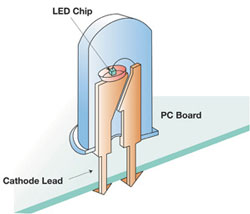 |
| Structure of 5-mm-type LED |
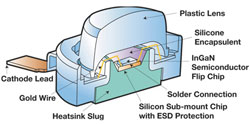 |
| Structure of a high=brightness LED
|
Common LED types and packages
LEDs come in two basic categories:
Low power LEDs
These commonly come in 5 mm size, although they are also available in 3 mm and 8 mm sizes. These are fractional wattage devices, typically 0.1 watt, operate at low current (~20 milliamps) and low voltage (3.2 volts DC), and produce a small amount of light, perhaps 2 to 4 lumens.
High power LEDs
These come in 1–3 watt packages. They are driven at much higher current, typically 350, 700, or 1000 mA, and – with current technology – can produce 40-80 lumens per 1-watt package. High power LEDs come in many different shapes and sizes.
Color quality of white LEDs
Color quality has been one of the key challenges facing white light-emitting diodes (LEDs) as a general light source. This section reviews the basics regarding light and color and summarizes the most important color issues related to white light LEDs, including recent advances.
Light and color basics
Light-emitting diodes (LEDs) differ from other light sources, such as incandescent and fluorescent lamps, in the way they generate white light. We are accustomed to lamps that emit white light. But what does that really mean? What appears to our eyes as "white" is actually a mix of different wavelengths in the visible portion of the electromagnetic spectrum. The diagram to the right illustrates visible light as one small portion of the overall electromagnetic spectrum. Electromagnetic radiation in wavelengths from about 380 to 770 nanometers is visible to the human eye.
Incandescent, fluorescent, and high-intensity discharge (HID) lamps radiate across the visible spectrum, but with varying intensity in the different wavelengths. The spectral power distribution (SPD) for a given light source shows the relative radiant power emitted by the light source at each wavelength. Incandescent sources have a continuous SPD, but relative power is low in the blue and green regions. The typically "warm" color appearance of incandescent lamps is due to the relatively high emissions in the orange and red regions of the spectrum.
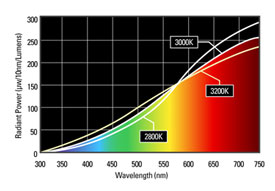 |
| Example of a typical incandescent spectral power distribution |
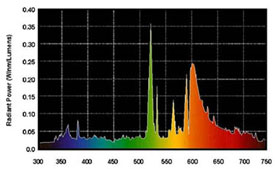 |
| SPX35 Tri-phosphor fluorescent. Image: GE Lighting |
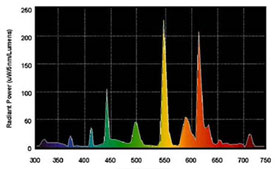 |
| ConstantColor® ceramic metal Halide. Image source: GE Lighting |
SPDs for fluorescent and HID sources are provided for comparison. These sources have "spikes" of relatively higher intensity at certain wavelengths, but still appear white to our eyes.
Unlike incandescent, fluorescent and HID sources, LEDs are near-monochromatic light sources. An individual LED chip emits light in a specific wavelength. This is why LEDs are comparatively so efficient for colored light applications. In traffic lights, for example, LEDs have largely replaced the old incandescent + colored filter systems. Using colored filters or lenses is actually a very inefficient way to achieve colored light. For example, a red filter on an incandescent lamp can block 90 percent of the visible light from the lamp. Red LEDs provide the same amount of light for about one-tenth the power (12 watts compared to 120+ watts) and last many times longer. However, to be used as a general light source, "white" light is needed. LEDs are not inherently white light sources.
See also:
Making white light with LEDs
White light can be achieved with LEDs in two main ways: 1) phosphor conversion, in which a blue or near-ultraviolet (UV) chip is coated with phosphor(s) to emit white light; and 2) RGB systems, in which light from multiple monochromatic LEDs (red, green, and blue) is mixed, resulting in white light.
The phosphor conversion approach is most commonly based on a blue LED. When combined with a yellow phosphor (usually cerium-doped yttrium aluminum garnet or YAG:Ce), the light will appear white to the human eye. Research continues to improve the efficiency and color quality of phosphor conversion.
The RGB approach produces white light by mixing the three primary colors - red, green, and blue. The color quality of the resulting light can be enhanced by the addition of amber to "fill in" the yellow region of the spectrum.
Each approach to producing white light with LEDs (described above) has certain advantages and disadvantages. The key trade-offs are among color quality, light output, luminous efficacy, and cost. The technology is changing rapidly due to intensive private and publicly funded research and development efforts in the U.S., Europe, and Asia. The primary pros and cons of each approach at the current level of technology development are outlined below.
| Advantages | Disadvantages | |
| Phosphor conversion | ||
| RGB |
Luminous efficacy and color characteristics of current white LEDs
How do currently available white LEDs compare to traditional light sources in terms of color characteristics and luminous efficacy? Standard incandescent A-lamps provide about 15 lumens per watt (lm/W), with CCT of around 2700 K and CRI close to 100. ENERGY STAR-qualified compact fluorescent lamps (CFLs) produce about 50 lm/W at 2700-3000 K with a CRI of at least 80. Typical efficacies of currently available LED devices from the leading manufacturers are shown below. Improvements are announced by the industry regularly. Note the efficacies listed below do not include driver or thermal losses.
| CCT | CRI | 70-79 | 80-89 | 90+ |
| 2600-3500 K | 23-43 lm/W | 25 lm/W | ||
| 3500-5000 K | 36-73 lm/W | 36-54 lm/W | ||
| > 5000 K | 54-87 lm/W | 38 lm/W | ||
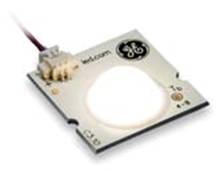 |
Most currently available white LED products are based on the blue LED + phosphor approach. A recent product (see photo to the right) is based on violet LEDs with proprietary phosphors emphasizing color quality and consistency over time. Phosphor-converted chips are produced in large volumes and in various packages (light engines, arrays, etc.) that are integrated into lighting fixtures. RGB systems are more often custom designed for use in architectural settings.
Comparing LEDs to traditional light sources
Energy efficiency proponents are accustomed to comparing light sources on the basis of luminous efficacy. To compare LED sources to CFLs, for example, the most basic analysis should compare lamp-ballast efficacy to LED+driver efficacy in lumens per watt. Data sheets for white LEDs from the leading manufacturers will generally provide "typical" luminous flux in lumens, test current (mA), forward voltage (V), and junction temperature (Tj), usually 25°C. To calculate lm/W, divide lumens by current times voltage. As an example, assume a device with typical flux of 45 lumens, operated at 350 mA and voltage of 3.42 V. The luminous efficacy of the LED source would be:
45 lumens/(.35 amps × 3.42 volts) = 38 lm/W
To include typical driver losses, multiply this figure by 85%, resulting in 32 lm/W. Because LED light output is sensitive to temperature, some manufacturers recommend de-rating luminous flux by 10% to account for thermal effects. In this example, accounting for this thermal factor would result in a system efficacy of approximately 29 lm/W. However, actual thermal performance depends on heat sink and fixture design, so this is only a very rough approximation. Accurate measurement can only be accomplished at the luminaire level.
Lifetime of white LEDs
One of the main "selling points" of LEDs is their potentially very long life. Do they really last 50,000 hours or even 100,000 hours? It depends on LED quality, system design, operating environment, and other factors. This section provides information on lumen depreciation and life measurement for LEDs compared to other light sources.
Lumen depreciation
All types of electric light sources experience lumen depreciation, defined as the decrease in lumen output that occurs as a lamp is operated. The causes of lumen depreciation in incandescent lamps are depletion of the filament over time and the accumulation of evaporated tungsten particles on the bulb wall. This typically results in 10% to 15% depreciation compared to initial lumen output over the 1,000 hour life of an incandescent lamp.
In fluorescent lamps, the causes of lumen depreciation are photochemical degradation of the phosphor coating and the glass tube, and the accumulation of light-absorbing deposits within the lamp over time. Specific lamp lumen depreciation curves are provided by the lamp manufacturers. Current high quality fluorescent lamps using rare earth phosphors will lose only 5–10% of initial lumens at 20,000 hours of operation. Compact fluorescent lamps (CFLs) experience higher lumen depreciation compared to linear sources, but higher quality models generally lose no more than 20% of initial lumens over their 10,000 hour life.
Lumen depreciation in LEDs varies depending on package and system design. The primary cause of lumen depreciation is heat generated at the LED junction. LEDs do not emit heat as infrared radiation (IR) like other light sources, so the heat must be removed from the device by conduction or convection. If the LED system design has inadequate heat sinking or other means of removing the heat, the device temperature will rise, resulting in lower light output. Clouding of the epoxy encapsulant used to cover some LED chips also results in decreased lumens making it out of the device. Newer high-power LED devices use silicone as an encapsulant, which prevents this problem. LEDs continue to operate even after their light output has decreased to very low levels. This becomes the important factor in determining the effective useful life of the LED.
Defining LED useful life
To provide an appropriate measure of useful life of an LED, a level of acceptable lumen depreciation must be chosen. At what point is the light level no longer meeting the needs of the application? The answer may differ depending on the application of the product. For a common application such as general lighting in an office environment, research has shown that the majority of occupants in a space will accept light level reductions of up to 30% with little notice, particularly if the reduction is gradual. Therefore a level of 70% of initial light level could be considered an appropriate threshold of useful life for general lighting. Based on this research, the Alliance for Solid State Illumination Systems and Technologies (ASSIST), a group led by the Lighting Research Center (LRC), recommends defining useful life as the point at which light output has declined to 70% of initial lumens (abbreviated as L70) for general lighting and 50% (L50) for LEDs used for decorative purposes. For some applications, a level higher than 70% may be required.
Measuring light source of life
We've all heard the small "pop" as an incandescent lamp fails. It's the sound of the tungsten filament finally breaking as the electric current hits it. This makes it easy to recognize the end of life for an incandescent light source. With fluorescent lamps, end of life may involve flickering or the lamp may simply not activate when the switch is turned on. With LEDs, outright failure of the device is less likely, although it can happen due to component failure. Instead, the LED's light output slowly declines over time.
The lifetimes of traditional light sources are rated through established test procedures. The life testing procedure for compact fluorescent lamps, for example, is published by the Illuminating Engineering Society (IES) as LM-65. It calls for a statistically valid sample of lamps to be tested at an ambient temperature of 25 degrees Celsius using an operating cycle of 3 hours ON and 20 minutes OFF. The point at which half the lamps in the sample have failed is the rated average life for that lamp. For 10,000 hour lamps, this process takes about 15 months.
How are LED lifetimes rated? Life testing for LEDs is impractical due to the long expected lifetimes. Switching is not a determining factor in LED life, so there is no need for the on-off cycling used with other light sources. But even with 24/7 operation, testing an LED for 50,000 hours would take 5.7 years. Because the technology continues to develop and evolve so quickly, products would be obsolete by the time they finished life testing.
A life testing procedure for LEDs is currently under development by the Illuminating Engineering Society of North America (IESNA). The proposed method is based on the idea of "useful life," i.e., the operating time in hours at which the device's light output has declined to a level deemed to no longer meet the needs of the application. For example, for general ambient lighting, the level might be set at 70% of initial lumens. Useful life would be stated as the average number of hours that the LED would operate before depreciating to 70% of initial lumens.
The leading LED manufacturers have begun using the L70 language, stating that their white LEDs "are projected" to have lumen maintenance of greater than 70% on average after 50,000 hours when used in accordance with published guidelines.
Electrical and thermal design of the LED system or fixture determine how long LEDs will last and how much light they will provide. Driving the LED at higher than rated current will increase relative light output but decrease useful life. Operating the LED at higher than design temperature will also decrease useful life significantly.
How do the lifetime projections for LEDs compare to traditional light sources?
| Light source | Range of typical rated life
(hours)* (varies by specific lamp type) |
Esimated useful life (L70) |
| incandescent | 750–2,000 | |
| halogen incandescent | 3,000–4,000 | |
| dompact fluorescent (CFL) | 8,000–10,000 | |
| metal halide | 7,500–20,000 | |
| linear fluorescent | 20,000–30,000 | |
| high-power white LED | 35,000–50,000 |
Usable light
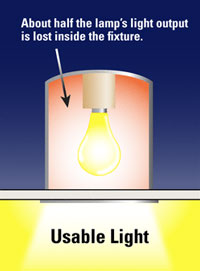 |
Luminous efficacy is an important indicator of energy efficiency, but it doesn't tell the whole story, particularly with regard to directional light sources.
Due to the directional nature of their light emission, LEDs potentially have higher application efficiency than other light sources in certain lighting applications. Fluorescent and standard "bulb" shaped incandescent lamps emit light in all directions. Much of the light produced by the lamp is lost within the fixture, reabsorbed by the lamp, or escapes from the fixture in a direction that is not useful for the intended application. For many fixture types, including recessed downlights, troffers, and under-cabinet fixtures, it is not uncommon for 40–50% of the total light output of the lamp(s) to be lost before it exits the fixture.
LEDs emit light in a specific direction, reducing the need for reflectors and diffusers that can trap light, so well-designed fixtures, like the undercabinet light shown below, can deliver light more efficiently to the intended location.
LED applications
The small size and inherent directionality of white LEDs make them a promising option for a number of general illumination applications. This section looks at the advantages and disadvantages of using LEDs in recessed downlights, kitchen undercabinet lighting, and portable desk/task light designs. It also includes discussions of using LEDs to their best advantage based on a number of unique characteristics, as well as issues surrounding dimming LEDs in residential applications.
